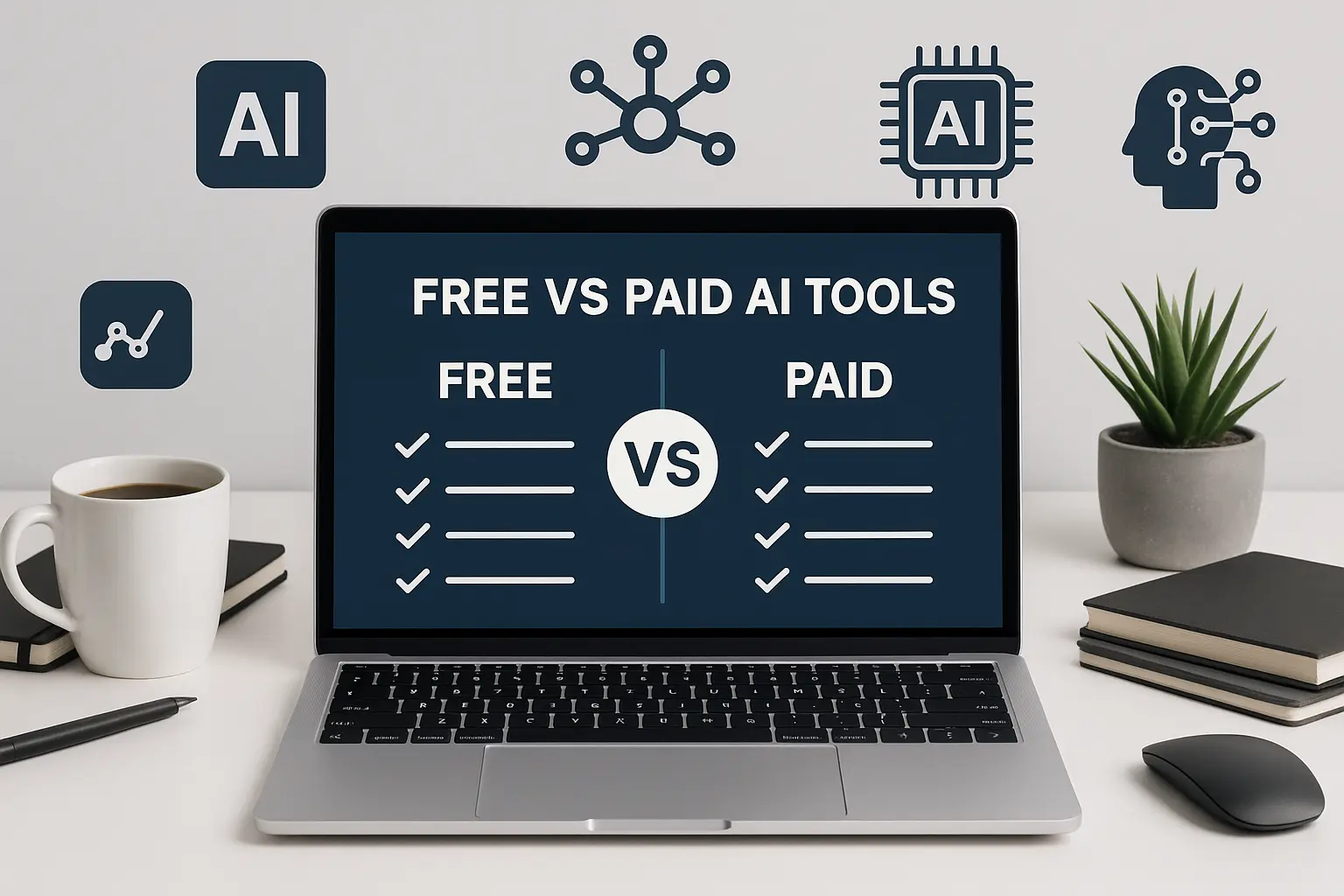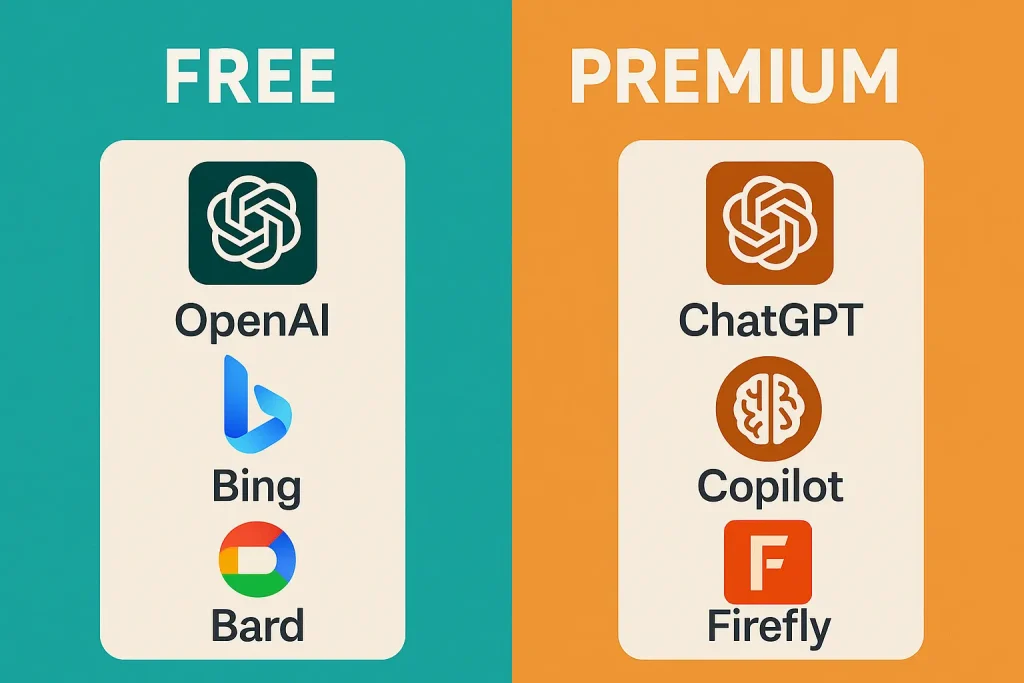Free vs Paid AI Tools: What’s Worth Paying For in 2025?

AI tools have exploded in popularity—becoming the digital co-pilots of modern business. From automating repetitive tasks to writing full-length blog posts or generating custom code, artificial intelligence is no longer just a futuristic concept—it’s a daily reality.
But here’s the big question every entrepreneur, marketer, and creator is asking:
Are paid AI tools really worth it—or can free ones get the job done?
In this guide, we’ll cut through the hype and compare free vs paid AI tools across use cases, pricing, features, and ROI. Whether you’re a startup founder trying to stay lean, a content creator exploring automation, or a team leader optimizing workflows, this breakdown will help you choose where to invest—and where you can save.
Expect real-world examples, feature comparisons, and insights by use case—so you walk away with clarity, not confusion.
The Real Difference Between Free and Paid AI Tools
At first glance, free AI tools seem incredibly generous. You get access to sophisticated capabilities—text generation, image creation, chatbots, even code writing—without paying a dime. But here’s the truth: free tools often come with hidden limitations that only show up when you start using them seriously.
Let’s break it down.
Common Limitations of Free AI Tools
- Usage caps: Most free plans limit daily/monthly generations or word count (e.g., ChatGPT Free has limited GPT-3.5 access).
- Model restrictions: Free versions typically exclude the latest models like GPT-4, Claude Opus, or Midjourney v6.
- Lack of integrations: You often can’t connect with third-party platforms (like Zapier, Google Docs, or WordPress).
- No team collaboration: Free tools are usually built for solo users—not teams or businesses with shared workflows.
- Branding & watermarks: Image and video AI tools may watermark outputs unless you upgrade.
What You Get with Paid AI Tools
When you subscribe to a premium plan, you’re paying for more than just “unlocked” features. You’re buying productivity, scalability, and reliability.
Here’s what paid AI tools typically offer:
- Access to advanced models (like GPT-4, Claude 3, or Gemini Pro)
- Faster response times and priority servers
- Custom prompt templates and workflow automation
- API access for developers and businesses
- Dedicated support and SLA guarantees
- Collaboration tools for teams and organizations
🔎 Example:
Notion AI’s free tier lets you summarize pages and generate content, but the Pro version adds unlimited generations, workflow integrations, and priority access during peak hours—crucial for teams running content operations.
When Free AI Tools Are Enough
Not every situation demands a premium subscription. In fact, some of the most successful solopreneurs, students, and side-hustlers build entire workflows using only free AI tools.

Here’s when free is totally fine—and even smart.
Ideal Use Cases for Free AI Tools
- Early-stage entrepreneurs: Need to test an idea, build a landing page, or create MVP content? Free AI tools are perfect for quick launches.
- Freelancers or creatives: If you’re handling one-off client work, drafting social captions, or writing personal blog content, free tools can be surprisingly capable.
- Students & researchers: Need help summarizing notes, drafting outlines, or generating citations? Tools like ChatGPT Free or Notion AI (limited tier) do the job well.
- Bootstrapped startups: In your pre-revenue phase, minimizing SaaS spend is key. Free AI tools help you stay lean while still operating like a team of five.
Top Free AI Tools That Deliver Real Value
| Tool | Strength | Free Limitations |
|---|---|---|
| ChatGPT Free | Text generation, brainstorming | GPT-3.5 only, no plugins or web browsing |
| Canva AI | Design + AI copywriting | Limited exports, some templates locked |
| Notion AI | Writing, summarization, planning | Limited usage per month, slower generation |
| Quillbot | Rephrasing, grammar assistance | Word cap, no advanced fluency modes |
| Krisp AI | Noise cancellation (calls) | 60 min/day usage cap |
🔍 Real-World Scenario:
A freelance copywriter uses ChatGPT Free to draft blog outlines, Canva AI to design social media graphics, and Quillbot to polish client copy—spending $0 while delivering polished work.
🚀 Pro Tip: For side projects or lean startups, prioritize tools that offer long-term freemium plans instead of time-limited trials.
What You Get With Paid AI Tools (And When It’s Worth It)
As your business scales, or your demands grow more complex, free tools start to show their limits. That’s when it makes sense to invest in paid AI tools that offer enhanced capabilities, consistency, and deeper control.

Here’s where the value really shows up.
Upgrades You Get with Paid AI Tools
- Latest models & tech: Access GPT-4, Claude Opus, Midjourney v6—often exclusive to premium plans
- Custom workflows: Set up automations, saved prompts, and team-specific templates
- Faster output: Reduced latency, queue skipping, and priority server access
- API & integration access: Connect AI tools with your CRM, CMS, or internal dashboards
- Advanced content controls: Tone customization, brand voice adherence, plagiarism tools
- Team management: Role-based access, user permissions, shared projects
💼 For Teams & Businesses
Paid AI platforms often come with collaboration features, multi-user environments, and security protocols (like SSO or audit logs)—essential for growing teams or agencies.
📊 Example:
A digital agency upgrades to Jasper AI Pro. Why? They need GPT-4, SEO-optimized long-form content, team permissions, and integration with Surfer SEO. The $59/month plan offsets hours of manual work.
🔐 When It’s Time to Upgrade
Ask yourself:
- Are you hitting usage caps regularly?
- Do you need faster, more accurate, or higher-quality outputs?
- Is your team scaling or are you managing multiple clients?
- Do you need API access, white-label exports, or advanced privacy controls?
If yes—you’ve outgrown the free tier.
Cost vs Value: Are Paid AI Tools Worth It?
Let’s be real—paying $20, $60, or even $120 a month for an AI tool can feel like a stretch, especially when free versions exist. But here’s where the rubber meets the road: are those extra dollars generating real returns—or just more features you never use?
Breaking Down the True Cost
| Tool | Monthly Cost (Base Plan) | Key Premium Benefit |
|---|---|---|
| ChatGPT Plus | $20 | GPT-4, web browsing, file uploads, plugins |
| Jasper AI | $49–$69+ | Brand voice, long-form SEO tools, team collaboration |
| Copy.ai | $49 | Workflows, unlimited words, sales-specific templates |
| Writesonic | $19–$99 | GPT-4, Surfer SEO, bulk content |
| Midjourney | $10–$60+ | Higher-resolution images, commercial license, fast mode |
But cost alone doesn’t tell the whole story. Let’s talk value.
Measuring the ROI of Paid AI Tools
Here’s what makes a paid AI subscription truly worth it:
- Time savings: If a tool saves you 10+ hours a month, that’s time you can reinvest elsewhere.
- Revenue generation: Paid AI can help you create content that ranks, converts, or closes deals.
- Scalability: Premium AI allows you to build repeatable workflows, not just one-off outputs.
- Client deliverables: Higher-quality outputs mean better client satisfaction—and retention.
🧠 Example:
A content strategist uses Jasper’s premium SEO mode to produce 10 high-ranking blog posts per month. One post brings in 2 new leads worth $1,000 in potential revenue. The $59 monthly fee? Covered multiple times over.
📌 Pro Tip: Don’t just look at what you’re paying—ask what you’re saving or earning back.
Industry-Specific AI Tool Recommendations
The best AI tool for a designer won’t be the same one a software developer swears by. Use case matters. So does your industry.

Let’s break down the most relevant free vs paid AI tools by sector:
🧠 For Marketers
- Free: ChatGPT (for ideation), Canva AI (for visuals), Hemingway (for clarity)
- Paid: Jasper AI (for SEO), Surfer AI (for content strategy), Writesonic (for ads)
💡 Upgrade Reason: Better brand voice consistency, SERP-optimized content, faster output
👩💻 For Developers
- Free: GitHub Copilot (limited trial), TabNine Basic, Replit AI
- Paid: GitHub Copilot Pro, Amazon CodeWhisperer, CodiumAI
💡 Upgrade Reason: Access to full repositories, inline code suggestions, and API documentation support
🎨 For Designers & Creatives
- Free: Canva AI (image generation), Photopea (AI editing), Leonardo AI (limited)
- Paid: Midjourney (high-res assets), Runway ML (video editing), Adobe Firefly (enterprise use)
💡 Upgrade Reason: Commercial licensing, advanced rendering, export quality
📈 For Business Owners & Teams
- Free: Notion AI, ChatGPT, Mixo.io (site builder)
- Paid: Zapier AI, Copy.ai Workflows, Durable AI CRM
💡 Upgrade Reason: Automation, data integrations, workflow scalability
🎯 Pro Insight: If your business relies on repeatable tasks, client-facing content, or technical accuracy, paid AI tools are a smart investment—not just a convenience.
AI Tool Comparisons by Use Case
Not all AI tools are created equal—and the “best” tool often depends entirely on what you’re trying to do. Let’s map the right tool to the right job so you’re not wasting time or money.

🔍 Best Free AI Tools for Content Creation
- ChatGPT Free (GPT-3.5): Ideal for outlines, blog intros, idea generation
- Grammarly Free: Basic grammar and tone checking
- Canva AI: Content visuals + basic copywriting prompts
📎 Use Case: A blogger uses ChatGPT Free to brainstorm blog titles, Grammarly for edits, and Canva AI to design post graphics—no cost, solid results.
💸 Top Paid AI Tools for Automation
- Copy.ai Pro: End-to-end marketing workflows (emails, product descriptions, landing pages)
- Jasper AI Boss Mode: Content creation + brand voice + SEO integrations
- Zapier AI: Connects AI tools to CRMs, CMSs, and more for full process automation
📎 Use Case: A small e-commerce brand automates their weekly email campaigns using Copy.ai and integrates it with Klaviyo via Zapier AI.
📧 Free vs Paid Tools for Email Copywriting
| Tool | Free Tier | Paid Upgrade |
|---|---|---|
| Flowrite | 15 messages/month, limited tone options | Unlimited messages, tone customization |
| Lavender | Basic AI suggestions | Sales coaching, personalization tools |
| Copy.ai | Limited generations | Unlimited copy + workflows |
📎 Use Case: A cold outreach team starts with Flowrite Free but switches to Lavender Premium for deeper personalization and tracking.
🛠 AI Tools for Customer Support
- Free: Tidio AI, ChatGPT (for internal agent scripts), Crisp AI (lite)
- Paid: Intercom Fin, Freshchat AI, ChatGPT API for chatbots
📎 Use Case: A SaaS startup begins with ChatGPT-powered macros for their agents, but transitions to Intercom Fin for scalable, automated support.
Security, Data, and Privacy Considerations
While features and pricing often dominate the conversation around AI tools, there’s a quieter—but equally important—factor at play: data security and privacy.
Especially if you’re handling client information, customer data, or proprietary systems, this is non-negotiable.
🔐 What You Should Know About Free AI Tools
- Data training risks: Many free tools use your inputs to train their models—meaning your sensitive info could indirectly influence public outputs.
- No enterprise-level compliance: Free plans rarely offer GDPR, HIPAA, or SOC 2 compliance.
- Lack of access controls: No role-based permissions or audit trails.
- No uptime or SLA guarantees: If the system goes down, support is limited or nonexistent.
📎 Example: A law firm drafts confidential client letters with ChatGPT Free—unaware that the tool may retain input data unless a paid privacy-compliant plan is used.
✅ What Paid Plans Offer (From a Security Standpoint)
- Data isolation: Your inputs are siloed and not used to train models (e.g., OpenAI’s ChatGPT Team and Enterprise plans)
- API-level encryption: Ensures safe transmission of data
- Compliance certifications: Look for SOC 2, ISO 27001, HIPAA, or GDPR badges
- Custom privacy terms: Enterprise tools often allow custom legal agreements and SLAs
📎 Use Case: A healthcare startup switches from a freemium chatbot to a HIPAA-compliant AI assistant using a paid API provider like AWS Bedrock or Azure OpenAI.
🎯 Pro Tip: If your work involves regulated industries (healthcare, law, finance) or handles customer data at scale, free tools may be a legal risk—not just a technical one.
Final Verdict: Free vs Paid AI Tools – What’s Worth Paying For?
Here’s the bottom line:
Free AI tools are perfect for:
- Solopreneurs, side-hustlers, students, and creators testing ideas
- Simple content tasks, light productivity needs, and learning the ropes
- Anyone operating on a lean budget or experimenting before scaling
Paid AI tools are worth it when:
- You need access to advanced features like GPT-4, integrations, or custom workflows
- Your output quality directly affects client satisfaction, revenue, or growth
- Security, compliance, or uptime are mission-critical
🧠 Think of it this way:
If free AI tools are the bicycle—agile and efficient for small distances—paid AI tools are the electric vehicle that gets you farther, faster, and with more comfort.
📌 Still not sure? Start free. Hit the limits. Then upgrade when it hurts your productivity or scalability.
FAQs About Free vs Paid AI Tools
Q1: Is ChatGPT Plus worth it over the free version?
Yes—if you need GPT-4, access to plugins, file uploads, and web browsing. For basic tasks, free is fine. For professionals, Plus unlocks a serious performance edge.
Q2: What are the risks of using free AI tools for business?
Data privacy, limited output quality, and lack of control. Free tools might not meet industry compliance standards (GDPR, HIPAA, etc.), and your data could be used to train public models.
Q3: Are there any forever-free AI tools worth using long term?
Yes! Tools like Canva AI, Notion AI (with limits), Grammarly, and ChatGPT Free offer long-term value with consistent performance—especially for basic content or admin tasks.
Q4: Do paid AI tools guarantee better content?
Not automatically—but they do give you better tools, flexibility, and customization. The quality still depends on how well you use them.
Q5: Can I mix free and paid AI tools effectively?
Absolutely. Many professionals use a hybrid AI stack—e.g., free ChatGPT for drafts, paid Jasper for final SEO content, and Canva Pro for visuals.


